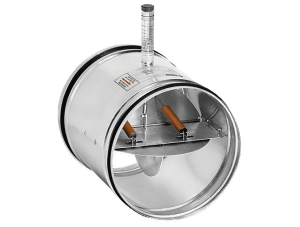VAV System (Variable Air Volume)
Overview:
Variable Air Volume (VAV) control is designed to save energy. In laboratories, airflow from hoods and exhaust systems is controlled. Reducing the extracted air volume reduces the need for replacement air. The majority of energy used in fume hood operation is for heating, cooling, and conditioning replacement air.
VAV control monitors sash height or face velocity and adjusts the air volume accordingly using fast-acting motorized dampers or similar devices.
Key Features and Advantages:
- Controls airflow in the 50–1000 Pa pressure range without external power
- Complies with EN 1751, air leakage class C
- User-adjustable airflow, with the ability to maintain two selected flow rates using 24V or 230V actuators
- Air velocity range: 0.2–12 m/s
- Operating temperature: 10–80 °C
- Easy installation in supply and exhaust ducts, vertically or horizontally
- Available in round or rectangular options, with optional sealing on service lines
VAV-A – High-Speed Variable Airflow Controller Features:
- Fast, adaptive control algorithm for precise and stable control
- Control time 3–5 s for 90° angle
- Suitable for supply and exhaust airflow control in laboratories and cleanrooms
- Free system programming and monitoring of all actual values
- Monitoring of customer ventilation systems via supply/exhaust setpoints
- Static differential pressure transmitter for continuous measurement in the 3–300 Pa range (optional 8–800 Pa)
Advantages:
- Maintains proper face airflow when sash position changes, improving safety
- Easily adapts to system changes, increasing laboratory flexibility
- Alarm and monitoring functions are integral to the VAV system
- Room pressure and supply air control
- Supports auto sash closure devices and reminders
CAV and VAV in HVAC Systems (Reference: Your Text)
In ventilation and airflow control systems for laboratories and cleanrooms, CAV and VAV are two main methods for controlling temperature and airflow. Each method has its own features, advantages, and specific applications.
CAV System (Constant Air Volume)
Overview:
The CAV100 is a constant air volume controller designed for automatic control of a fixed airflow in ventilation systems. This system maintains a constant air volume, even when static pressure in the duct changes. The CAV operates automatically and does not require an external power supply.
It is highly suitable for maintaining stable airflow in laboratories, cleanrooms, and spaces with relatively constant thermal loads.
Specifications and Features:
- Airflow range: 2 to 12 m/s
- Operating pressure: 50 to 1000 Pa
- Standards: Complies with EN 1751; casing leakage class C, close blade leakage class 0
- User-adjustable: Set values can be independently changed by the user
- Factory version: Can be supplied with default factory settings or customized values
- Installation: Suitable for both supply and exhaust ducts, vertically or horizontally
Advantages:
- Maintains constant airflow even with varying duct static pressure
- Automatic operation without external power
- Ensures stable temperature and airflow control in laboratories and cleanrooms
- High user flexibility in setting airflow values
- Meets international standards for air leakage (EN 1751)
Applications:
- Laboratories and cleanrooms with constant thermal loads
- Airflow control in laboratory fume hoods
- Spaces sensitive to airflow and air quality requiring stability and safety



